USCIS Releases Report About FY 2022 H-1B Visa Allocations

June 27, 2023
The United States Citizenship and Immigration Services (USCIS) released a new report on the number and distribution of H-1B visa approvals. This report provided considerable information regarding the allocation of employment-based visas. Most notably, the report has shown that most specialty occupation visas have gone to individuals born in India. Here are some of the highlights of the USCIS’s announcement.
The report titled Characteristics of H-1B Specialty Occupation Workers – 2022 revealed that H-1B petitions for specialty occupations increased by 19.1% from FY 2021 to 2022. According to the report, the numbers increased from 398,296 to 474,301 in FY 2022. Of the 474,301 filed visas, the USCIS approved 442,043. This approval rating revealed an 8.6% increase in FY 2022 from FY 2021.
Employers should know that federal law allows an annual cap of 85,000 visas in a given fiscal year. However, the law allows exemptions for specific categories of employers, such as those in higher education. These exemptions have caused the number of granted visas to exceed the cap.
Of the beneficiaries of these visas, 62.8% had a bachelor’s or master’s degree, and 7.6% had a doctorate. The median compensation for these workers also increased by 9.8% to $118,000 in FY 2022. Among the remaining beneficiaries, 31% had a professional degree, and the last 26% had an unknown level of education. Many of the recipients in the 26% indicated that their level of education did not have electronic records.
The most notable statistics in this report included which countries received the visas. In FY 2022, 320,791 Indians received 72.6% of approved H-1B visas. This statistic marks a significant increase over the 301,000 approved in fiscal year 2021. The second largest number went to China, with 55,038 approvals, accounting for 12.5% of the total approved applications. The third largest number, with 4,235 approved applications, went to Canada, representing 1% of the total approvals.
For all approved applications, these numbers include petitions for initial employment and extensions. Petitions for continuing employment comprised 68% of the total number. In addition, this marked a 4% increase in the number of initial applications over the previous fiscal year.
According to the USCIS’s data, demand for foreign national workers has continued to increase. As such, employers should consider documentation requirements, such as what workers will need for the employment eligibility verification (Form I-9) process. Many employers have struggled with Form I-9s, which all workers must complete, regardless of citizenship or immigration status. The best way to ensure compliance is to incorporate an electronic I-9 management tool to guide personnel through every step of the verification process.
Learn more about automating your employment eligibility verification and ensuring compliance with I-9Compliance.